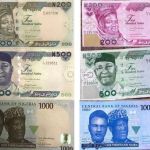Naira’s Volatile Journey: From Strength to Uncertainty
Analyzing the Recent Fluctuations in Nigeria's Currency

The Nigerian Naira has recently been on a rollercoaster ride, with its value fluctuating dramatically against the US dollar. On October 7th, 2023, the Naira was exchanged at a rate of N997 to the dollar in the black market, showing a slight appreciation from the previous day’s rate of N1,000. However, this positive trend in the parallel market was not mirrored in the Investors and Exporters (I&E) window, where the Naira weakened from N756.21 to N775.2 per dollar.
This disparity between the two markets has raised eyebrows, with the difference in exchange rates being N221.8, a decrease from the N243.79 gap earlier in the week. Experts have attributed the Naira’s modest recovery in the black market to the resumption of international flights by several foreign airlines. However, the I&E window continues to experience pressure due to persistent demand, leading to further depreciation of the local currency.
The Central Bank of Nigeria (CBN) has been proactive in its approach to stabilize the Naira, emphasizing its commitment to managing both the official and black market foreign exchange markets. Despite these efforts, the Naira’s value has been a topic of concern for many, especially considering its historical strength.
A look back at the 1970s reveals a time when the Naira held significant value. Graduating students from the University of Nigeria could expect a monthly salary of about N2,000, equivalent to or even surpassing US$4,000 at that time. Fast forward to today, and the Naira’s purchasing power has drastically diminished, with many attributing its decline to various economic and political factors.
Historically, the Naira’s downfall began during periods of military rule, where individuals with little economic expertise took control of the nation’s finances. The currency’s value continued to plummet with the transition of these military leaders into politics, wearing civilian attire and making promises of economic revival.
Several factors have contributed to the Naira’s current state, including the decline in oil production and prices, inflation, and external debts. The Central Bank’s measures to stabilize the currency, such as increasing the Monetary Policy Rate and the Cash Reserves Ratio, have been met with skepticism. Critics argue that these policies have further depreciated the Naira against foreign currencies, especially the US dollar.
Between 2022 and 2023, the Naira depreciated by over 50% in both the I&E and parallel markets. This rapid depreciation has had ripple effects on the Nigerian economy, affecting sectors like agriculture and industry. The nation’s overreliance on oil and gas, coupled with issues like petroleum subsidy and oil theft, has further weakened the Naira’s position both locally and globally.
In conclusion, the future of the Naira remains uncertain. While there are potential solutions to stabilize the currency, such as increasing foreign exchange availability and promoting stable investments, the ultimate fate of the Naira lies in the hands of Nigeria’s policymakers and leaders. Only time will tell if they can steer the nation towards economic stability and restore the Naira’s former glory.



















